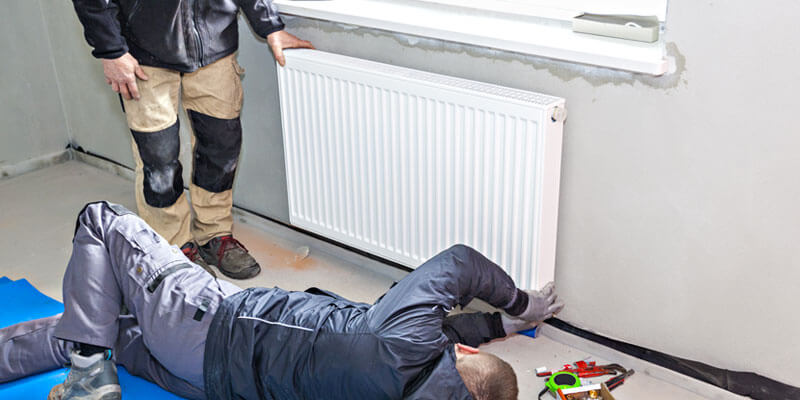Many DIY hobbyists enjoy completing routine maintenance jobs in and around their homes themselves, which is a brilliant way to save money. However, some tasks are trickier than others! One such task is the relocation of a radiator, which can cause a lot of damage if not done correctly.
As highly-experienced plumbers who regularly complete maintenance services such as radiator replacements and boiler repairs in Milton Keynes, we know a thing or two about central heating systems. In this article, we will share our knowledge with you and guide you through how to move a radiator effectively.
Subscribe To Our Newsletter
Receive advice, tips and recent updates when you sign up.
How To Move A Radiator In Your Home
As plumbers in Buckingham and Milton Keynes, we have completed many boiler installations in Milton Keynes and the surrounding areas over the years. Almost all of them will require either a new radiator to be fitted or an existing one to be relocated. Some customers prefer to relocate radiators themselves to save money – this is not a problem, as long as you know what you’re doing: making a mistake when relocating a double convector radiator can become quite serious. You could potentially damage the heating system, damage pipework or even flood the room from which you’re trying to move it. This article will guide you through how to move a radiator correctly at home so that you don’t fall victim to a domestic plumbing disaster.

How Easy Is It To Move A Radiator?
Well, how easy is it to move a radiator? The answer to this question depends on several factors, such as your level of understanding of plumbing and heating systems and your commitment to the task! You will require the assistance of a licensed plumber to handle the pipework involved in this job, but apart from that, anybody can move a radiator with a little bit of patience.
Our Guide To Moving A Radiator
You Will Need:
- Two adjustable wrenches
- A notepad and pencil
- A container
- Towels
- Your radiator key
- A ruler
- A drill
1. Turn Off The Heating And Valves
This crucial first step is essential in ensuring your safety whilst relocating your radiator. You must first turn off your central heating and wait for the system to cool to avoid the risk of burns. Next, turn the thermostatic radiator valve – or TRV – off and use a wrench to twist the lock-shield valve clockwise to close it to isolate your radiator from the rest of the system. Write down the number of times you turn the lock-shield valve to close it: this will help you restore your radiator’s original pressure once refitted.
Before you can start draining, you’ll need to turn off the boiler and isolate the electricity supply. If you try to drain the system with the electricity supply still running, you could find that the boiler fires back up or the pump may start, which could lead to the boiler burning out or overheating.
2. Measure The Radiator And Its New Location
Before getting into the exciting plumbing aspects of the relocation, you must measure the radiator in its current position before removal. This is so that you know how much space you’re going to need on the new wall when it comes to refitting the radiator. Remember to measure the space between the bottom of the radiator and the floor to allow for the pipework running to and from it.
When moving a radiator to a different wall, don’t forget to check that you have enough space for the radiator in its intended location, as well as confirming the integrity of the wall you plan to hang the radiator on. If there are any cracks or weak points, you should take care of these first to ensure that your wall can cope with the weight of the radiator. Finally, check with a licensed plumber that your chosen spot is equipped with the necessary pipework.

3. Drain The Radiator
Before you can start ripping radiators off of walls, you’ll need to drain your radiator of any water, or you could find yourself flooding the place and causing a lot of damage.
How To Move A Radiator Without Draining The System
It is not necessary to drain the whole system down when moving a radiator: you can isolate and drain that particular radiator, making the task a lot simpler.
Prepare to drain your radiator by placing a container over a towel underneath one of the valves before undoing the nut joining the radiator and the valve. You can do this with two wrenches, placing one on the valve and using the other to carefully undo the nut, allowing water to drain into the container.
Using your radiator key, open the bleed valve to drain more water before closing it again and moving to the other side of the radiator. Repeat the process of loosening the nut joining the valve and the radiator to drain the radiator. Once again, open the bleed valve to remove excess water.
You can now completely loosen the nuts on both sides, disconnecting the radiator from the valves before carefully lifting it off its brackets. If your radiator is large or heavy, consider asking someone for assistance. Gently tilt the radiator to the side to drain any remaining water into the container.
At this point, you may also want to take the opportunity to clean any sludge (a build-up of dirt and rust) out of your radiator. For a guide on how to do this, check out our previous article.
4. Cap The Pipework
When you’re satisfied that the radiator is empty, you can temporarily stuff the radiator valve inlets with tissue paper to prepare the radiator for moving. You must also permanently cap off the valve outlets which are no longer in use: you will need to enlist the help of a professional plumber to do this, as it is dangerous and illegal to do it yourself. As plumbers in Milton Keynes and Buckingham, we use a soldering method to do this that provides secure capping.
5. Moving A Radiator To A Different Wall
You are now ready to fit the radiator onto the new wall. Measure the height of the radiator brackets on the old wall, as well as the distance between them. Remove the brackets from the wall and use these measurements to reattach them to the new wall, using a drill and the screws and wall plugs that came with your radiator. You can use a spirit level to ensure proper placement.
Carefully lift and lower your radiator onto the brackets, making sure that they align with the ones on the back of your radiator. Make sure that the TRV and lock-shield valve are closed. You will require the help of a professional plumber to execute the necessary pipework and hook up your radiator to the pipes. PTFE tape should be applied to the thread of pipework before tightening a fitting, creating a buffer and preventing gas or fluid from leaking out of the system. Once the radiator is secured and all drain and bleed points are tightly shut, you can proceed to refill the radiator.
6. Refill The System
After all of the necessary pipework is completed by a plumber, you can start to refill the system. You can do this by first opening the TRV and lock-shield valve before opening the bleed valves until water begins to spit out. At this point, you will need to close the bleed valves.
When the radiator has been refilled, you can reconnect the boiler’s electricity supply, turn on your central heating and test the new radiator. Make sure that the boiler is able to reach the correct pressure. If it isn’t, you’ll need to get a registered gas engineer to take a look.
Common Radiator FAQs
How To Move A Radiator With Flexible Pipes
Flexible radiator pipes are a great option for those who want to minimise the amount of pipe visible next to their radiator. Relocating radiators with flexible pipes only requires a couple of extra steps. First, drain the radiator as above. Once empty, you can disconnect the Flexi pipes from the radiator, cap them off using push-fit stop ends, then tuck them back into the wall. Consult a plumber to have flexible pipes installed in the new location of the radiator.
How To Move A Radiator With A Combi Boiler
The above method can be followed for radiators with combi boilers or any pressurised system. It is unnecessary to drain the entire system; shutting the TRV and lock-shield valve isolates the radiator. After this process, you may need to re-pressurise your boiler, so ensure that you know how to do that before completing this task.

Get Help From Licensed Plumbers
We hope that our article has informed you on how to move a radiator and empowered you to try it yourself! Almost anyone can relocate a radiator with a bit of patience, but it is a challenging task. At Bishop Plumbing & Heating, we prioritise high-quality service, preventing damage to your home and ensuring a comfortable environment year-round. If you’d like our help or would rather leave it to the professionals, you can get in contact with our team of plumbers in Milton Keynes and Buckingham. If you are having problems with your radiator, check out this article by B&Q.












